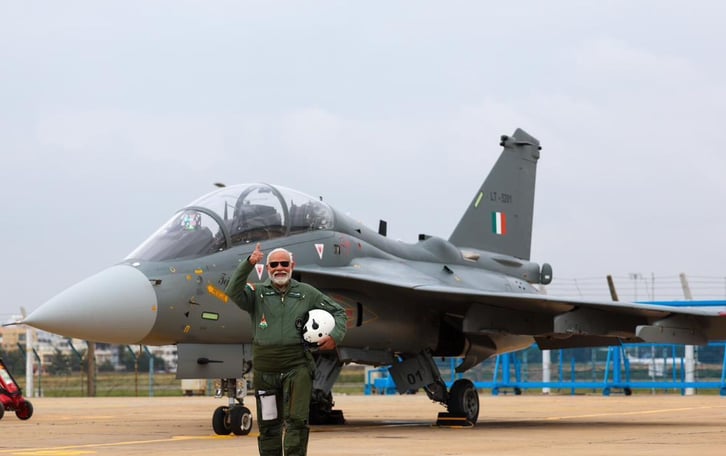

The Indian Air Force (IAF), the world’s fourth-largest air force, faces significant challenges in maintaining air superiority amidst an evolving geopolitical landscape. With the possibility of a two-front war involving China and Pakistan, the urgency to modernize and expand its fighter jet fleet has never been greater. However, delays in indigenous fighter aircraft development, a slow-paced procurement process and technological hurdles have hindered the IAF’s capability buildup.
Despite efforts to reduce dependency on foreign aircraft, indigenous projects like the Light Combat Aircraft (LCA) Tejas and the Advanced Medium Combat Aircraft (AMCA) continue to face developmental and production delays. Simultaneously, the long-pending Multi-Role Fighter Aircraft (MRFA) procurement remains undecided, affecting the IAF’s fighter squadron strength. This article explores these critical challenges and their implications for India’s air power.
The Two-Front War Challenge: A Shrinking Fighter Squadron Strength
The IAF ideally requires 42 fighter squadrons to counter simultaneous threats from China and Pakistan. However, as of 2024, it operates with just 30 squadrons, well below the sanctioned strength. Several aging aircraft, including the MiG-21, MiG-27 and MiG-29, are set to retire soon, further widening the gap.
China’s Growing Air Superiority
China’s People’s Liberation Army Air Force (PLAAF) has significantly modernized its fleet, inducting 5th-generation stealth fighters like the J-20 and developing advanced drones and hypersonic missiles.
The PLAAF has strategically deployed its fighters at airbases in Tibet and Xinjiang, increasing its aerial reach into Ladakh and Arunachal Pradesh.
China has also strengthened its partnership with Pakistan, jointly developing the JF-17 Thunder and supplying J-10C fighters, improving Pakistan’s air combat capabilities.
Pakistan’s Expanding Fleet
Pakistan Air Force (PAF) has been rapidly modernizing, acquiring advanced F-16 Block 70 aircraft from the U.S. and Chinese J-10C fighters to counterbalance the IAF’s superiority.
The induction of these jets has given the PAF an edge in Beyond Visual Range (BVR) combat capabilities, particularly with the PL-15 missile, which outmatches the IAF’s existing arsenal.
Without rapid induction of modern aircraft, the IAF risks losing its qualitative edge in the event of a conflict. The delays in indigenous projects and acquisitions are only exacerbating this challenge.
Slow Pace of Technology Research and Development
One of the biggest obstacles in India’s defense aviation sector is the slow and inconsistent progress in indigenous fighter aircraft development. The Defence Research and Development Organisation (DRDO), Hindustan Aeronautics Limited (HAL) and other private sector players have struggled with:
Engine development: India still lacks a fully indigenous fighter jet engine, relying on General Electric (GE) engines for the Tejas and Russian engines for the Su-30MKI. The indigenous Kaveri engine project has failed to meet operational requirements, delaying self-reliance efforts.
Avionics and radar systems: Indian-built radars and avionics have lagged behind global standards. The development of an indigenous Active Electronically Scanned Array (AESA) radar has been slow, affecting modern fighter jet performance.
Weapons integration: Integration of indigenous weapons like the Astra BVR missile and BrahMos-NG has faced delays due to prolonged testing and certification processes.
The need for an efficient and time-bound defense R&D ecosystem is critical if India is to achieve true self-reliance in fighter aircraft production.
LCA Tejas: Successes and Continuing Challenges
The Light Combat Aircraft (LCA) Tejas program, initiated in the 1980s, was meant to replace India’s aging MiG-21 fighters. However, decades of delays and technological hurdles meant that the first squadron was inducted only in 2016—over 30 years after the project began.
Key Successes
Induction into the IAF: The IAF has ordered 40 Tejas Mk1 fighters and 83 Tejas Mk1A variants, with improved avionics and weapons systems.
Export potential: Several countries, including Malaysia, Egypt and Argentina, have shown interest in purchasing Tejas, boosting India’s defense exports.
Indigenous capability development: Tejas has helped India master composite airframe technology, digital flight control systems and AESA radar development.
Challenges Hindering Tejas
Slow production rate: HAL has struggled to scale up production, delivering only six to eight aircraft per year against the IAF’s requirement for faster inductions.
Dependency on foreign components: Tejas still relies on American engines (GE F404/F414), Israeli radars, and European subsystems, reducing its indigenous content.
Delayed Tejas Mk2: The more capable Tejas Mk2, featuring a more powerful engine, improved stealth and greater payload capacity, is still in the design phase, with first flight expected only by 2026.
While the Tejas program has made progress, it is far from replacing the depleting IAF squadrons at the required pace.
MRFA Procurement: Still Awaiting a Final Decision
The Multi-Role Fighter Aircraft (MRFA) procurement program, earlier known as the MMRCA 2.0, aims to acquire 114 foreign fighter jets to bolster the IAF’s fleet. However, no final decision has been made, despite urgent operational needs.
Competing Aircraft
Several global aerospace giants have bid for the MRFA contract, including:
Dassault Rafale (France)
Lockheed Martin F-21 (USA)
Boeing F-15EX & F/A-18 Super Hornet (USA)
Eurofighter Typhoon (EU Consortium)
Saab Gripen E (Sweden)
Sukhoi Su-35 & MiG-35 (Russia)
Key Challenges in MRFA Selection
Budget constraints: The procurement is estimated to cost over $18 billion, making it one of the IAF’s costliest acquisitions.
Strategic partnerships: The deal mandates local production under Make in India, requiring foreign firms to set up facilities in India, which has slowed negotiations.
Geopolitical considerations: With growing ties with the U.S., France and Russia, India must carefully balance political and strategic interests in selecting the final aircraft.
Any further delays in the MRFA deal will only worsen the IAF’s squadron shortage.
AMCA: The Future of India’s Air Power?
The Advanced Medium Combat Aircraft (AMCA) is India’s ambitious 5th-generation stealth fighter project, meant to rival China’s J-20. Designed by DRDO and HAL, the AMCA is expected to feature:
Stealth capabilities with radar-absorbent materials.
Supercruise and thrust vectoring for superior maneuverability.
Indigenous AESA radar and electronic warfare systems.
Challenges Facing the AMCA Program
Engine development delays: India is in talks with the U.S. (GE), UK (Rolls-Royce) and France (Safran) for co-developing a powerful 110 kN jet engine.
Funding and timelines: The AMCA’s first prototype is expected only by 2028, with production likely in the 2030s, leaving a long capability gap.
Lack of private sector participation: Unlike global fighter programs, AMCA’s development remains HAL-dominated, slowing progress.
If the AMCA program is not fast-tracked, India risks missing out on 5th-generation capabilities while rivals advance.
Conclusion
The Indian Air Force is at a critical crossroads, facing a shrinking fighter squadron strength and increasing regional threats. While indigenous programs like Tejas and AMCA are steps in the right direction, delays in production, technological advancements and procurement decisions continue to weaken India’s aerial combat preparedness.
A faster and more efficient decision-making process, increased private sector participation and sustained funding for indigenous R&D are essential to ensure the IAF remains a formidable force. The time to act is now—any further delays could compromise India’s national security in an increasingly hostile neighborhood.
